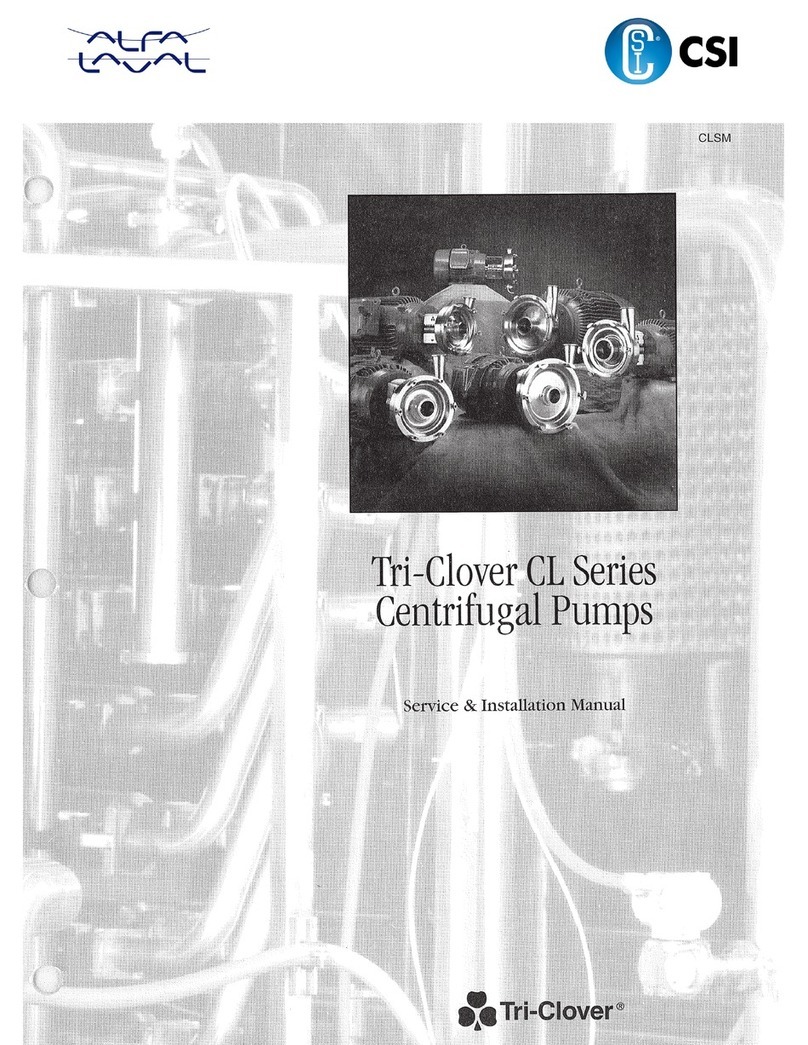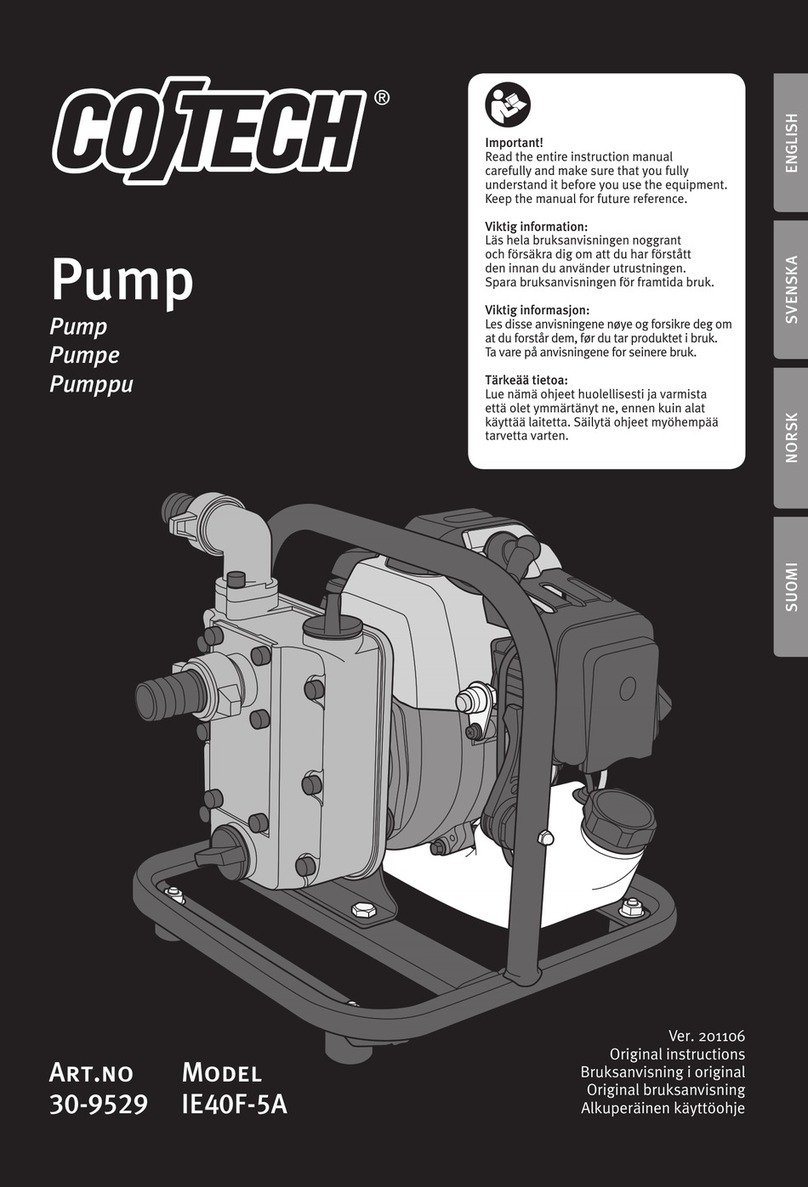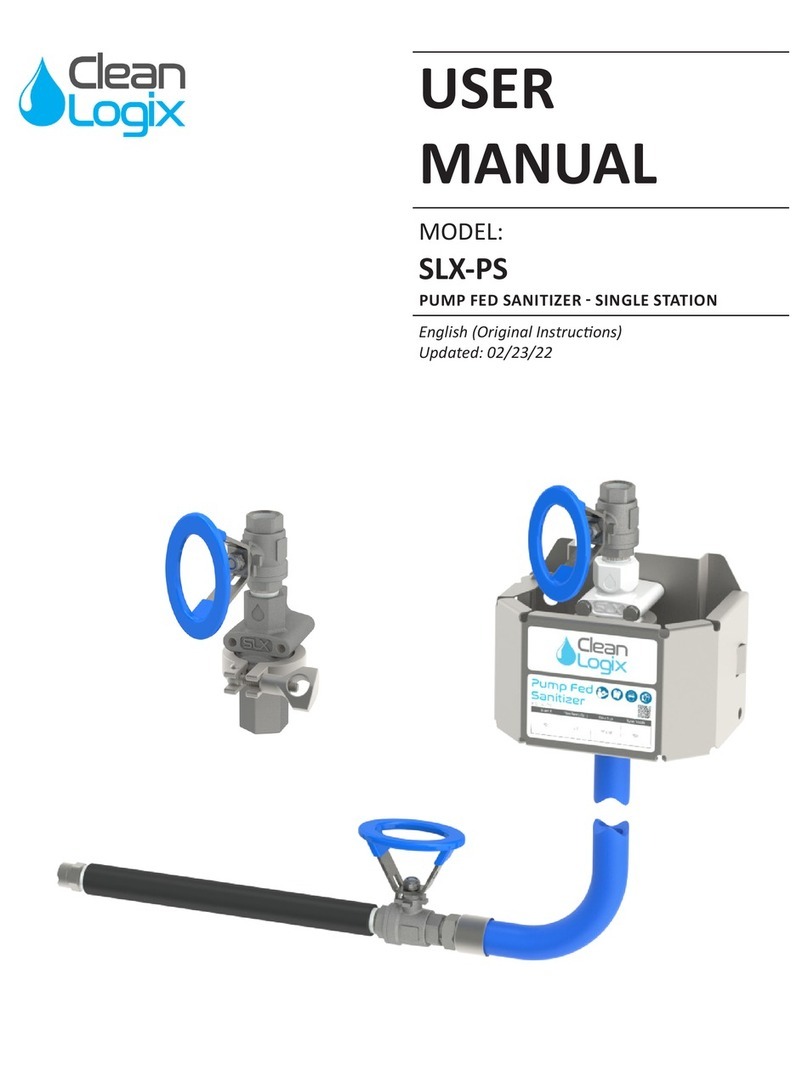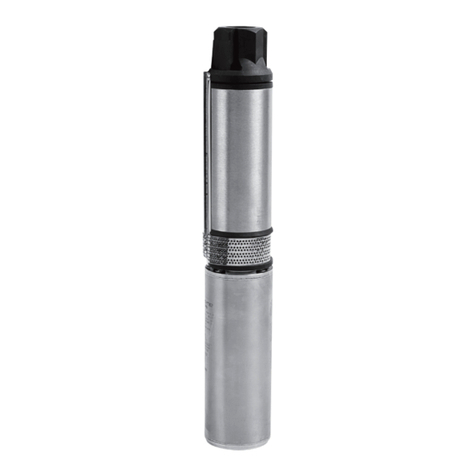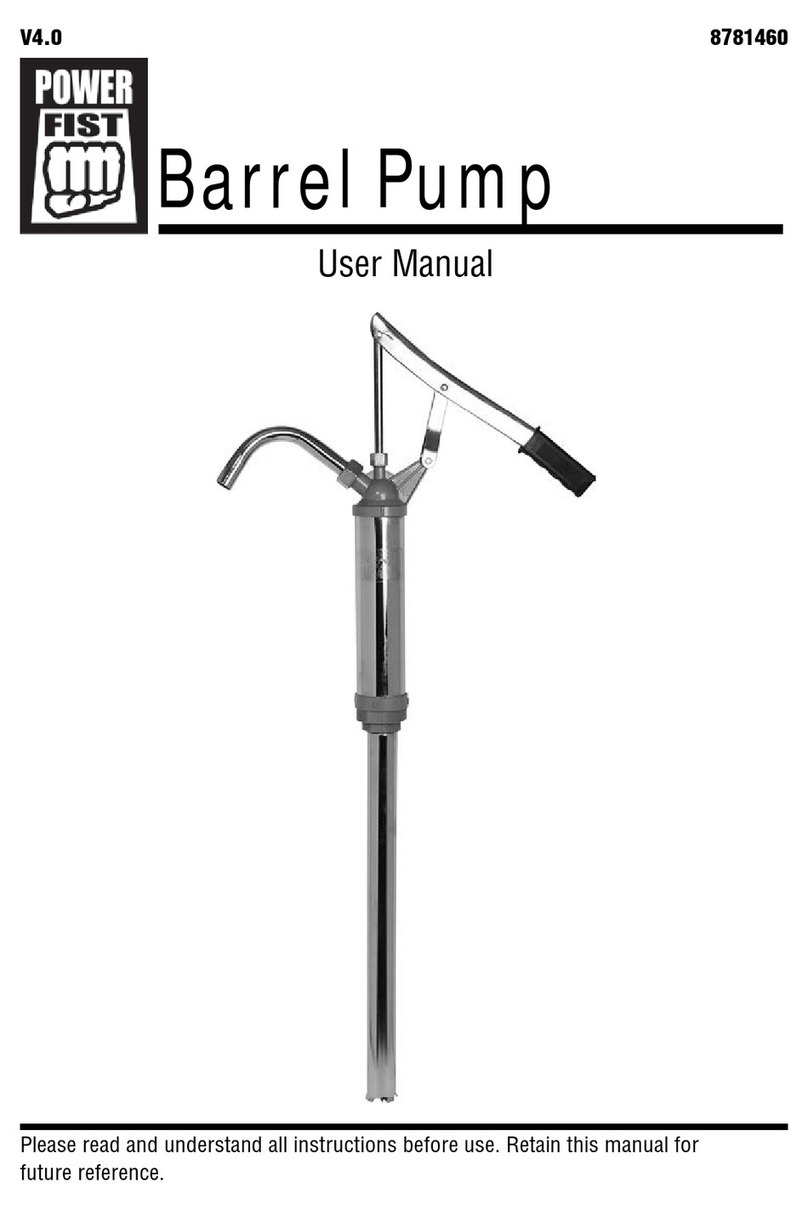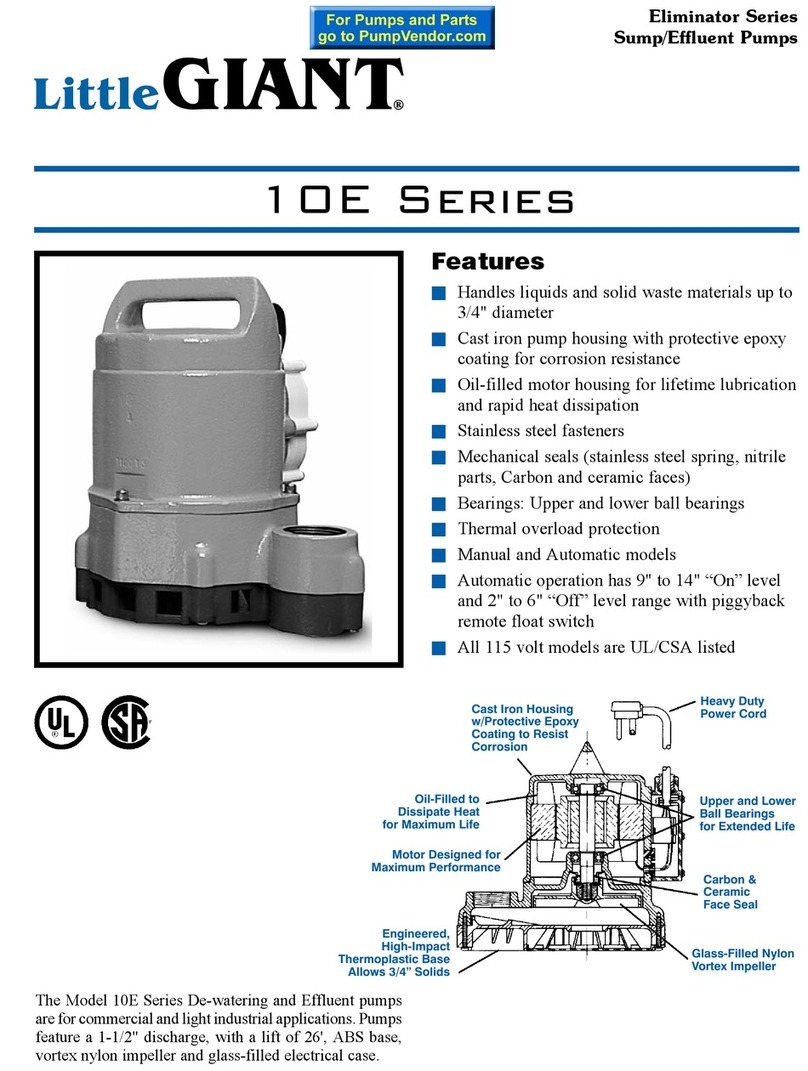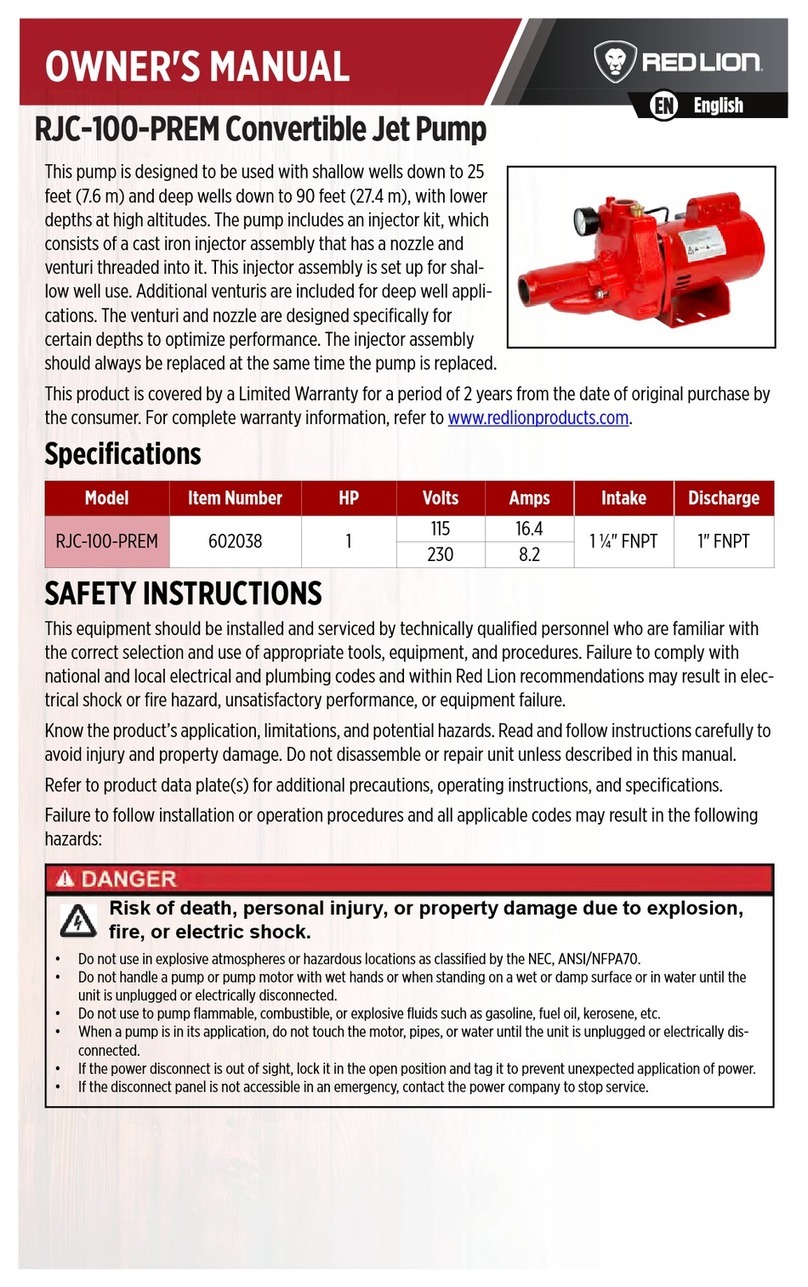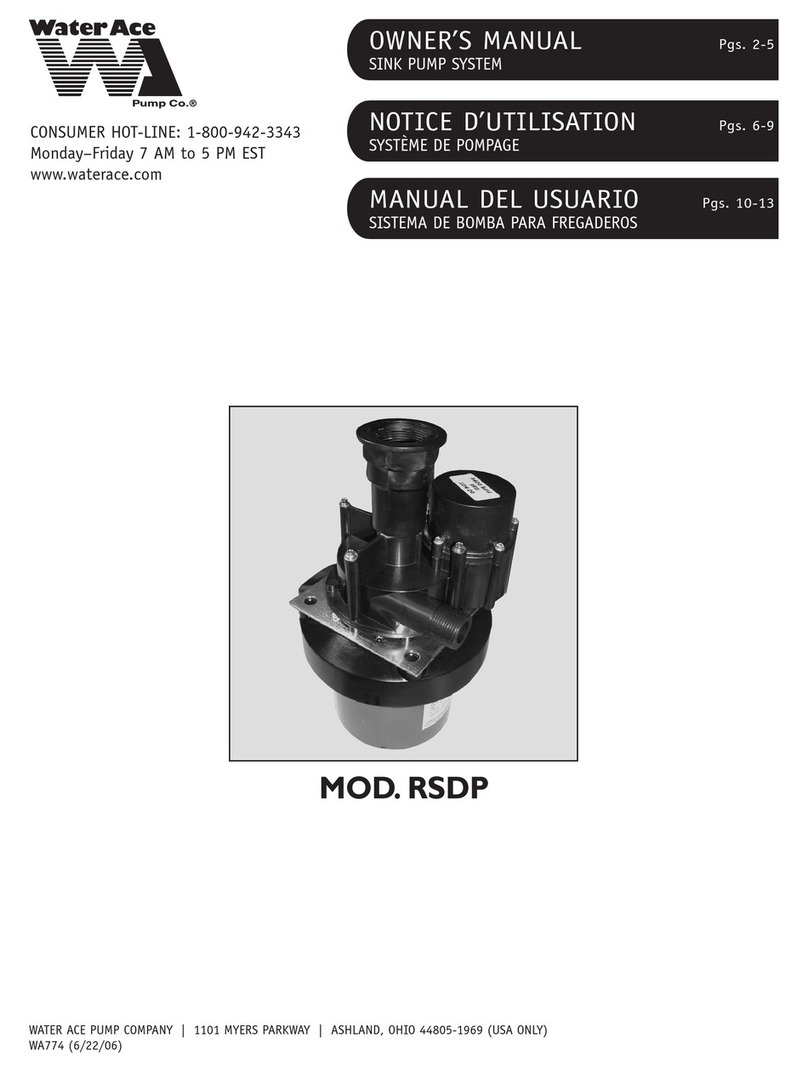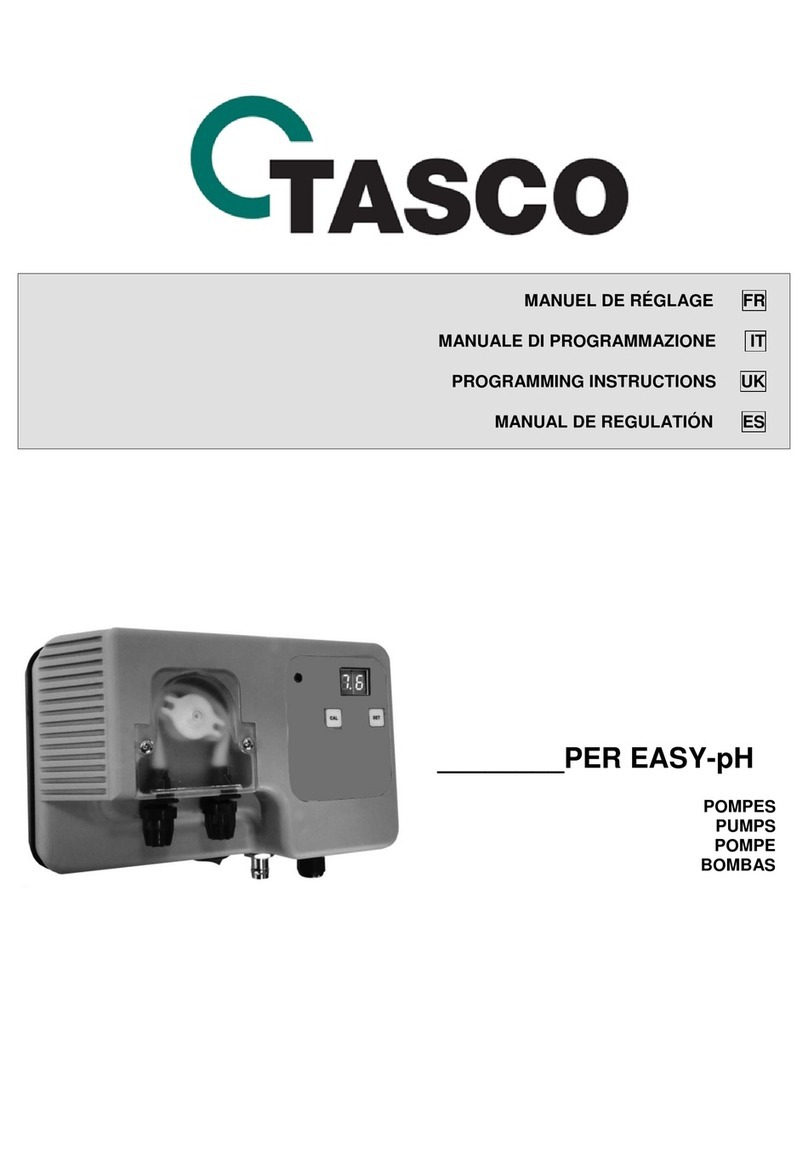FLYGT MP-3067 User manual

FLYGT MP-3067 PUMP
Safety Precautions
Before starting work on the pump, make sure that the pump is isolated from the power supply and cannot be
energized.
NOTE! This applies to the control circuit as well.
The following points are important in connection with work on the pump:
-Make sure the pump has been thoroughly cleaned.
-Observe good personal hygiene.
-Beware the risk of infection.
-Follow local safety regulations.
The pump is designed for use in liquids which can be hazardous to health. In order to prevent injury to the eyes and
skin, observe the following points when working on the pump:
-Always wear goggles and rubber gloves.
-Rinse the pump thoroughly with clean water before starting work.
-Rinse the components in water after disassembly.
-The oil housing may be under pressure. Hold a rag over the oil casing screw (oil plug) and the
inspection screw to prevent splatter.
Proceed as follows if you get hazardous chemicals in your eyes:
-Rinse immediately in running water for 15 minutes. Hold your eyelids apart with your fingers.
-Contact an eye specialist.
On your skin:
-Remove contaminated clothes.
-Wash your skin with soap and water.
-Seek medical attention, if required.
Make sure the pump cannot roll or fall over and injure people or damage property.
Inspection
Regular inspection and preventive maintenance ensure more reliable operation.
The pump should be inspected at least once a year, but more frequently under sever operation conditions.
Under normal operating conditions, the pump should have a major overhaul in a service shop at least every third
year for permanent installation and every year for portable pumps.
If the pump is new or if the seals have been replaced, inspections is recommended after one week of operation.
Regular check of the condition of the lifting handle and chain is important.
Inspection of hot water applications
Pumps in hot water applications shall undergo inspection or overhaul at a service shop as follow, depending on the
time they have been submerged in the hot water:
Temp.
Mode of Operation
Inspection
Shop Overhaul
≤ 70°C
(160°F)
Continuous
1000 hours
4000 hours
≤ 70°C
(160°F)
Intermittent
Twice a Year
Once a year
≤ 90°C
(195°F)
Cont./Int.
6 times a year
Twice a year

Recommended Inspections
Inspection of Action
Visible parts on pump Replace or fix worn and damaged parts.
and installation Make sure that all screws, bolts and nuts are tight.
Check the condition of carrying handle/lifting eyes, chains and wire ropes.
Check that the guide bars are vertical.
Pump casing and impeller Replace worn parts if they impair function.
Wear on the outlet flange on the pump casing usually causes wear on the
discharge connection.
Wear on the impeller and parts around it necessitates fine adjustment of the
impeller or replacement or worn parts. See “Replacing the impeller”.
Oil quantity WARNING. If the seal leaks, the oil casing may be under pressure. Hold
a rag over the oil casing screw in order to prevent splatter. See “Safety
Precautions” for additional information.
Check that the oil reaches up to the oil hole. Add oil as needed. See
“Changing the Oil.”
Condition of the oil A check of the condition of the oil can show whether there has been an
increase leakage. Note: Air/oil mixture can be confused with water/oil
mixture.
Insert a tube (or hose) into the oil hole. Cover the top end of the tube and
take up a little oil from the bottom.
Change the oil if it contains too much water, i.e., is heavily emulsified
(cream-like), or if the oil housing contains separated water. See “Changing
the Oil”. Check again once week after changing the oil.
If the oil contains too much water again, the fault may be:
that an oil screw is not sufficiently tight.
that an O-ring or its sealing surface is damaged.
that the lower mechanical seal is damaged.
Liquid in the stator casing WARNING. If there has been leakage, the stator casing may be under
pressure. Hold a rag over the inspection screw in to prevent splatter. See
“Safety Precautions” for additional information.
Turn the pump so the inspection hole faces downwards.
Tilt the pump so that any liquid in the stator casing can run out through the
hole.
If there is water in the stator casing, the cause may be:
that an O-ring is damaged.
that the cable entry is leaking.
If there is oil in the stator casing, the cause may be:
that the inner mechanical seal is damaged.

Inspection of Action
Cable Entry Make sure that the cable clamps are tight.
If the cable entry leaks:
check that the entry is firmly tightened into its bottom-most
position.
cut a piece of the cable off so that the seal sleeve closes around a
new position on the cable.
replace the seal sleeve.
check that the seal sleeve and the washers conform to the outside
diameter of the cables.
Cables Replace the cable if the outer jacket is damaged. Make sure that the cables
do not have any sharp bends and are not pinched.
Level sensors or other Check function. Clean, adjust, replace or repair damaged
level equipment level sensing equipment. Follow the instructions for the
level sensing equipment in question.
NOTE. The level sensor contains a mercury switch. Damaged sensors
should be disposed of in a proper manner.
Starter equipment If faulty, contact an electrician.
Monitoring equipment Check:
(should be checked often) - signals and tripping function.
- that relays, lamp, fuses and connections are intact.
Replace defective equipment.
Rotation direction of pump Transpose two phase leads if the impeller does not rotate
(requires voltage) clockwise as viewed from above. Rotation in the wrong direction reduces
the capacity of the pump and the motor may be overloaded. Check the
direction of rotation, during non-load every time the pump is reconnected.
Pipes, valves and other Repair faults.
peripheral equipment
Insulation resistance in the stator Use insulation tester. With a 1000 V-DC megger the insulation between
the phases and between any phase and ground should be > 1 MΩ.
Maintenance
Changing the Oil
Oil casing
WARNING. If the seal leaks, the oil casing may be under pressure. Hold a rag over the oil plug to prevent splatter.
1. Lay the pump on its side on a bench or over two supports.
2. Unscrew the oil casing screw.
3. Turn the pump so that the oil hole faces downwards. In order to get out all the oil, the pump must be raised
upright for a short while during drainage.
4. Fill up with 0.18 quarts of SAE 10W-30 motor oil. Always replace the O-rings of the oil hole screws. Put
the screws back and tighten them.
5. A paraffin oil approved by authorities (e.g. Mobil Whiterex 309) is recommended for raw or clean water
pumping.

Replacing the wear ring
When the clearance between the impeller skirt and the pump casing exceeds 0.08 in, the following replacement
must be made.
Replacing the wear ring in the pump casing
1. Disconnect and lift off the motor section from the pump casing.
2. Knock out the wear ring using a chisel.
3. Remove the wear ring.
4. Drive in the new wear ring. Use a rubber mallet or wooden block to prevent deformation.
The work will proceed more easily if the pump casing is first heated and/or the wear ring cooled.
Replacing the impeller
Removing the impeller
WARNING. Worn impellers often have very sharp edges.
1. Remove bolts and lift the motor section of the pump casing.
2. Lay the motor section on its side.
3. Remove the impeller screw.
4. Pull off the impeller. (Use impeller puller or two strong screwdrivers.)
Installing the impeller
1. Make sure that the end of the shaft is clean and free of burrs. Polish off any flaws with fine emery cloth.
2. Clean and oil all sealing surfaces and O-rings.
3. Check that the conical sleeve is seated on the shaft.
4. Grease end of shaft and impeller hub.
5. Mount the impeller and tighten the impeller screw.
6. Check that the impeller can be rotated by hand.
7. Fit the motor section to the pump casing. Make sure that the pump casing has the right orientation.
Troubleshooting
A universal instrument (VOM), a test lamp (continuity tester) and a wiring diagram are required in order to carry
out troubleshooting on the electrical equipment.
Troubleshooting shall be done with the power supply disconnected and locked off, except for those checks which
cannot be performed without voltage.
Always make sure that there is no one near the pump when the power supply is turned on.
Use the following checklist as an aid to troubleshooting. It is assumed that the pump and installation have formerly
functioned satisfactorily.
Electrical work shall be performed by an authorized electrician.
Follow local safety regulations and observe recommended safety precautions.
1. Pump fails to start
Is an alarm signal indicated
Yes
Check the cause:
on the control panel?
- If the bearing temperature is high, take the
pump to the shop for repairs.
No
- If the stator temperature is high, check that
the cooling system is working and that the
Impeller rotates easily.
- If there is a fault in the thermistors/thermal
switches, contact a service shop.
Check that the overload protection is reset.

Can the pump be started
Yes
a) Fault in the level equipment (start sensors).
manually?
Clean or replace.
b) Fault in control equipment.
No
Check:
- that all connections are intact.
- relay and contractor coils.
- that the control switch “Man/Auto” makes
contact in both positions.
Is the installation
No
Check:
receiving voltage?
- that the main power switch is on.
- that there is control voltage to the starter
Yes
equipment and its fuses are intact.
- that there is voltage in each phase of the
supply line.
- that all the fuses have continuity and are tight.
Is the start relay or the
Yes
Replace.
start capacitor defective?
(only for 1-phase motor)
No
Is the impeller stuck?
Yes
Clean.
WARNING: disconnect
Clean the sump.
power before checking
the impeller
No
Contact service shop.
2. Pump starts but motor protection trips
Is motor protection
Yes
Adjust.
set too low?
(Check with data plate)
No
Is the impeller difficult
Yes
Clean the impeller.
to rotate by hand?
Clean out the sump.
WARNING: disconnect
Check that the impeller is not adjusted
power before checking
too tight.
the impeller
If anything else is wrong, contact service shop.
No
Is the installation receiving
No
Check the motor fuses.
full voltage on all three
Notify an electrician.
phases?
Yes

Are the phase currents
Yes
Contact service shop.
uneven or too high?
No
Is the insulation between the
Yes
Contact service shop.
phases and ground in the
stator defective?
(Use insulation tester. With a
1000 V-DC megger, the
insulation between the phases
and between any phase and
ground should be > 1MΩ)
No
Is the density of the pumped
Yes
Dilute the liquid.
liquid too high? (Max density
Change to a more suitable pump.
1100 kg/m3, 9.2 lb/gal)
Contact service shop.
No
Fault on overload protection?
Yes
Replace the overload protection.
No
Contact service shop.
3. The pump does not stop.
Is the pump able to empty
No
Check:
the station to the stop level?
- for leakage in pipe and/or discharge
connection.
Yes
- that the impeller is not clogged.
WARNING: disconnect power before
checking the impeller.
- the non-return valve(s).
- that the pump has adequate capacity.
Fault in level sensing
Yes
Clean the level sensors.
equipment?
Check the functioning of level sensors.
Check the contactor and holding circuit.
No
Replace defective items.
Stop level set too low.
Yes
Raise the stop level.
No
Contact service shop.
4. The pump starts-stops-starts in rapid sequence
Does the pump start due to
Yes
Check:
backflow which fills sump to
- that the distance between the start and stop
start level again?
levels is not too small.
- the non-return valve(s).
No
- that the riser is not too long without a

non-return valve.
Does the contactor’s self-
Yes
Check:
holding function break?
- contactor connections.
- the voltage in the control circuit in relation
No
to the rated voltage on the coil.
- the functioning of stop sensor. The voltage
drop in the line at the starting surge makes
the contactor’s self-holding break.
Is the start relay correctly set?
No
Adjust.
(Only for 1-phase motor.)
Yes
Is the run capacitor defective?
Yes
Replace.
(Only for 1-phase motor.)
No
Contact service shop.
5. Pump runs but delivers too little or no water.
Check: -direction of rotation pump.
-that valves are open and intact.
-that pipes, impeller and strainer are not clogged.
-that the impeller rotates easily.
-that the suction lift has not been altered.
-for leakage in the pump installation.
-for wear on wear ring, impeller, pump casing/flange, suction bottom, diffuser, disc, diffuser.
See also under “Inspection”.
Do not override the motor protection repeatedly if it has tripped.

FLYGT MP-3102 & 3127 PUMP
Safety Precautions
Before starting work on the pump, make sure that the pump is isolated from the power supply and cannot be
energized.
NOTE! This applies to the control circuit as well.
The following points are important in connection with work on the pump:
-Make sure the pump has been thoroughly cleaned.
-Observe good personal hygiene.
-Beware the risk of infection.
-Follow local safety regulations.
The pump is designed for use in liquids which can be hazardous to health. In order to prevent injury to the eyes and
skin, observe the following points when working on the pump:
-Always wear goggles and rubber gloves.
-Rinse the pump thoroughly with clean water before starting work.
-Rinse the components in water after disassembly.
-The oil housing may be under pressure. Hold a rag over the oil casing screw (oil plug) and the
inspection screw to prevent splatter.
Proceed as follows if you get hazardous chemicals in your eyes:
-Rinse immediately in running water for 15 minutes. Hold your eyelids apart with your fingers.
-Contact an eye specialist.
On your skin:
-Remove contaminated clothes.
-Wash your skin with soap and water.
-Seek medical attention, if required.
Inspection
Regular inspection and preventive maintenance ensure more reliable operation.
The pump should be inspected after 2000 hours of operation or at least once a year, more frequently under sever
operation conditions.
Under normal operating conditions, the pump should have a major overhaul in a service shop after 6000 hours of
operation or every three years.
When the pump is new or when the seals have been replaced, inspections are recommended after one week of
operation.
Recommended Inspections
Inspection of Action
Visible parts on pump Replace or fix worn and damaged parts.
And installation Make sure that all screws, bolts and nuts are tight.
Check the condition of carrying handle/lifting eyes, chains and wire ropes.
Check that the guide bars are vertical.
Pump casing and impeller Replace worn parts if they impair function.
If the clearance between the impeller skirt and the pump casing exceeds
0.08 in, see “Replacing the wear ring”.

Inspection of Action
Wear on the outlet flange on the pump casing usually causes wear on the
discharge connection.
Oil quantity WARNING. If the seal leaks, the oil casing may be under pressure. Hold
a rag over the oil casing screw in order to prevent splatter. See “Safety
Precautions” for additional information.
Check that the oil reaches up to the oil hole when the pump is lying down.
Add oil as needed. See “Changing the Oil.”
Condition of the oil A check of the condition of the oil can show whether there has been an
increase leakage. Maximum permissible leakage of 0.05 ml/h (0.0017
oz/h). (Note: Air/oil mixture can be confused with water/oil mixture.)
Insert a tube (or hose) into the oil hole. Cover the top end of the tube and
take up a little oil from the bottom.
Change the oil if it contains too much water, i.e., is heavily emulsified
(cream-like), or if the oil housing contains separated water. See “Changing
the Oil”. Check again once week after changing the oil.
If the oil contains too much water again, the fault may be:
that an oil screw is not sufficiently tight.
that an oil screw O-ring or its sealing surface is damaged.
that an O-ring or its sealing surface is damaged.
that the lower seal is damaged.
Cable Entry Make sure that the gland screw is tight.
If the cable entry leaks:
check that the entry is tightened so it bottoms out.
cut a piece of the cable off so that the seal sleeve closes around a
new position on the cable.
replace the seal sleeve.
check that the seal sleeve and the washers conform to the outside
diameter of the cables.
Cables Replace the cable if the outer jacket is damaged. Make sure that the cables
do not have any sharp bends and are not pinched.
Level sensors or other Check function. Clean, adjust, replace or repair damaged
level equipment level sensing equipment. Follow the instructions for the
level sensing equipment in question.
NOTE! The level sensor contains a mercury switch. Damaged sensors
should be disposed of in a proper manner.
Starter equipment If faulty, contact an electrician.
Monitoring equipment Check:
(should be checked often) - signals and tripping function.
- that relays, lamp, fuses and connections are intact.
Replace defective equipment.

Inspection of Action
Rotation direction of pump Transpose two phase leads if the impeller does not rotate
(requires voltage) clockwise as viewed from above. Rotation in the wrong direction reduces
the capacity of the pump and the motor may be overloaded. Check the
direction of rotation every time the pump is reconnected.
Pipes, valves and other Repair faults.
Peripheral equipment
Insulation resistance in the stator Use insulation tester. With a 1000 V-DC megger the insulation between
the phases and between any phase and ground should be > 1 MΩ.
Maintenance
Changing the Oil
Oil casing
WARNING. If the seal leaks, the oil casing may be under pressure. Hold a rag over the oil plug to prevent splatter.
1. Lay the pump on its side on a bench or over two supports.
2. Unscrew the oil casing screw (OIL OUT).
3. Turn the pump so that the oil hole faces downwards. It is easier to drain the oil if the other oil hole screw is
also removed.
4. Fill up with 1.06 quarts (3102), 2.45 quarts (3127) of new oil (OIL IN). Always replace the O-rings under
the oil casing screw. Put the screws back and tighten them.
Use the following oil or their equivalent:
BP, Energol TOU 10W-30
Castrol, Castrolite 10W-30
Esso Extra Motor Oil 10W-30
Gulf Multi G 10W-30
Mobil Delvac Oil 1210
Delvac special 10W-30
Shell, Tractor Oil Universal 10W-30
Tellus T Oil 27
Shell Clavus Oil 27
Texaco Havoline Motor Oil 10W-40
Mobil Whiterex 309 or an equivalent paraffin oil is recommended for raw or clean water pumping.
Replacing the wear ring
When the clearance between the impeller skirt and the pump casing exceeds 0.08 in, the following replacement
must be made.
Replacing the wear ring in the pump casing.
1. Disconnect and lift off the motor section from the pump casing.
2. Knock out the wear ring using a chisel.
3. Drive in the new wear ring. Use a rubber mallet or wooden block to prevent deformation.
The work will proceed more easily if the pump casing is first heated and/or the wear ring cooled.
Assembly
Before assembling the pump, check the O-ring and fit it in place.

Replacing the impeller
Removing the impeller
WARNING. Worn impellers often have very sharp edges.
1. Remove bolts and lift the motor section of the pump casing.
2. Lay the motor section on its side.
3. Remove the impeller screw.
4. Pull off the impeller. (Use impeller puller.)
Installing the impeller
1. Make sure that the end of the shaft is clean and free of burrs. Polish off any flaws with fine emery cloth.
2. Clean and oil all sealing surfaces and O-rings.
Check:
-that the key is seated in the keyway on the shaft (3127).
-that the conical sleeve is seated in the impeller hub (3102).
3. Push the impeller onto the shaft.
4. Place washer on the impeller screw.
5. Tighten the impeller screw.
Installing the impeller, 3102 LT and LL version
Check that the whole sleeve is seated inside the impeller hub.
Push the impeller onto the shaft only so far as to allow the screw and washer to be screwed onto the shaft end.
Press the impeller onto the shaft with the impeller screw and tighten to the right torque.
Check that the impeller can be rotated by hand.
Fit the motor section to the pump casing. Make sure that the pump casing has the right orientation.
Don’t forget the O-ring.
Replacing the impeller on HS 3127
Removing the impeller (HS 3127)
WARNING. Worn impellers often have very sharp edges.
1. Lay the pump on its side.
2. Remove the nuts.
3. Remove the lower diffuser.
4. Remove the impeller screw.
5. Pull off the impeller by screwing a screw into the threaded washer.
Fitting the impeller (HS 3127)
Make sure that the end of the shaft is clean and free of burrs. Polish off any flaws.
1. Grease the end of the shaft and impeller hub.
2. Press the impeller onto the shaft with the impeller screw.
3. Tighten the impeller screw.
Adjusting the impeller (HS 3127)
1. Screw the adjusting nuts down toward the bottom of the studs.
2. Press the lower diffuser against the impeller.
3. Screw the adjusting nuts so that they lie flush against the lower diffuser.

4. Back off all adjusting nuts another half-turn (anti-clockwise).
5. Place the lower nuts on the studs.
6. Tighten the lower nuts evenly all around.
The clearance between the impeller and the lower diffuser shall be as little as possible.
Check that the impeller can easily be rotated by hand.
In order for the pump to perform at maximum capacity, the impeller must be adjusted regularly.
Troubleshooting
A universal instrument (VOM), a test lamp (continuity tester) and a wiring diagram are required in order to carry
out troubleshooting on the electrical equipment.
Troubleshooting shall be done with the power supply disconnected and locked off, except for those checks which
cannot be performed without voltage.
Always make sure that there is no one near the pump when the power supply is turned on.
Use the following checklist as an aid to troubleshooting. It is assumed that the pump and installation have formerly
functioned satisfactorily. Electrical work shall be performed by an authorized electrician. Follow local safety
regulations and observe recommended safety precautions.
1. Pump fails to start
Is an alarm signal indicated
Yes
Check the cause:
on the control panel?
- If the stator temperature is high, check that
the cooling system is working and that the
No
Impeller rotates easily.
- If there is a fault in the thermal protectors,
contact a service shop.
Check that the overload protection is reset.
Can the pump be started
Yes
a) Fault in the level equipment (start sensors).
manually?
Clean or replace.
b) Fault in control equipment.
No
Check:
- the control current.
- that all connections are intact.
- relay and contractor coils.
- that the control switch “Man/Auto” makes
contact in both positions.
Is the installation
No
Check:
receiving voltage?
- that the main power switch is on.
- that there is voltage in each phase of the
Yes
supply line.
- that all the fuses have continuity and are tight.
supply line.
- that the overload protection is reset.
- that there is no break in the motor cable.
Is the start capacitor
Yes
Replace.
defective?
(only for 1-phase motor)

No
Is the impeller stuck?
Yes
Clean.
WARNING: disconnect
Clean the sump.
power before checking
the impeller
No
Contact service shop.
2. Pump starts but motor protection trips
Is motor protection
Yes
Adjust.
set too low?
(Check with data plate)
No
Is the impeller difficult
Yes
Clean the impeller.
to rotate by hand?
Clean out the sump.
WARNING: disconnect
Check that the impeller is not adjusted too
power before checking
tight.
the impeller
If anything else is wrong, contact service shop.
No
Is the installation receiving
No
Notify an electrician.
full voltage on all three
phases?
Yes
Are the phase currents
Yes
Contact service shop.
uneven or too high?
No
Is the insulation between the
Yes
Contact service shop.
phases and ground in the
stator defective?
(Use insulation tester. With a
1000 V-DC megger, the
insulation between the phases
and between any phase and
ground should be > 1MΩ)
No
Is the density of the pumped
Yes
Dilute the liquid.
liquid too high? (Max density
Change to a more suitable pump.
1100 kg/m3, 70 lb/ft3)
Contact service shop.
No

Fault in bimetals in motor
Yes
Replace defective bimetals (over current
protection?
sensors).
No
Contact service shop.
3. The pump does not stop.
Is the pump able to empty
No
Check:
the station to the stop level?
- for leakage in pipe and/or discharge
connection.
Yes
- that the impeller is not clogged.
WARNING: disconnect power before
checking the impeller.
- the non-return valve(s).
- that the pump has adequate capacity.
Fault in level sensing
Yes
Clean the stop sensor.
equipment?
Check the contactor and holding circuit.
Replace defective items.
No
Stop level set too low.
Yes
Raise the stop level.
No
Contact service shop.
4. The pump starts-stops-starts in rapid sequence
Does the pump start due to
Yes
Check:
backflow which fills sump to
- that the distance between the start and stop
start level again?
levels is not too small.
- the non-return valve(s).
No
- that the riser is not too long without a
non-return valve.
Does the contactor’s self-
Yes
Check:
holding function break?
- contactor connections.
- the voltage in the control circuit in relation
No
to the rated voltage on the coil.
Contact service shop.
5. Pump runs but delivers too little or no water.
Check: -direction of rotation pump.
-that valves are open and intact.
-that pipes, impeller and strainer are not clogged.
-that the impeller rotates easily.
-that the suction lift has not been altered.
-for leakage in the pump installation.
-for wear on wear ring, impeller, pump casing/flange, suction bottom, diffuser, disc, diffuser.
See also under “Inspection”.
Do not override the motor protection repeatedly if it has tripped.

HYDROMATIC SPD50H/100H PUMP
Pump Servicing
Read the following instructions carefully before replacing any parts. Reasonable care and safe methods should be
practiced.
Tools Required
General tools include socket wrenches and a bearing puller. An ohmmeter is required to thoroughly check motor
and wiring.
For proper automatic operation, make sure the pump power cord is plugged into the piggyback receptacle on the
float switch cord.
Before removing the pump from its installation for repairs, check first to see if the trouble is caused by:
1. Miswiring of the pump into the terminal block.
2. Miswiring of the bloat level controls into the panel.
3. Miswiring inside the control panel.
4. Trip circuit breaker. If the breaker is manually reset and then trips off again, the problem could be:
a. short circuit in motor of control panel
b. water in the motor housing
c. insufficient amp capacity of wiring or breakers
d. improper panel wiring
5. Tripped overload. If the overload is manually reset and then trips off again, the problem could be:
a. pump or piping is clogged
b. pump motor or bearings may be defective
c. start capacitor in motor may have failed
d. pump may be misfired to terminal block
e. head is lower than rating, pumping too much liquid
6. Air locked pump. Disconnect piping at union and run until all air bubbles are expelled.
7. Wrong impeller rotation. Rotation should be counter-clockwise when looking at the impeller. Correct
improper rotation on three phase pumps by reversing any two line leads. No rotation check is necessary on
single phase pumps.
8. Closed discharge gate valve.
9. Plugged impeller or pipeline.
10. Discharge head may be too high. Check elevation against design point of pump.
11. Floats not hanging free in the sump.
12. Malfunctioning floats.
Disconnect power supply.
Checking Power Chord
To be sure wires are not burned off or broken in cord, use ohmmeter for check. Set ohmmeter scale pointer to R x
1 scale and attach one meter lead to white cord wire and one meter lead to black cord wire, then place a screwdriver
blade across terminals of plug. If cord is OK, meter needle will go to zero and stay there. If meter needle does not
move, this will indicate an open wire and cord must be replaced.

Motor
Warning: Be certain power to pump is off! Disconnect pump power cord from terminals in control panels
(manual pump models) and power source (automatic models) and remove pump from sump.
1. Clean any dirt or trash from the outside of the pump before dismantling.
If the unit is being operated by float or diaphragm switch, unplug the pump from the piggyback receptacle and
plug the pump directly into the power source. If the pump starts each time it is plugged directly into the
receptacle and does not start each time when plugged into the piggyback switch with the float raised or the
diaphragm switch pressed into the start position, replace the complete piggyback switch assembly and retest
with new assembly.
2. If motor does not run when tested as described above, the capacitor and/or stator must be checked.
Disconnect from power supply.
Remove plug from top of housing and pour oil into container, preferable clear, so that oil can be observed.
3. If oil is clear, it will indicate motor is not burned and there has been no water leak into the motor. If oil is
cloudy, it will indicate water in motor, or, if oil is black, it will indicate a burned stator.
4. After draining oil, carefully loosen the power cord assembly from the motor housing. With power cord loose,
remove the four wire nuts and screws and carefully lift off the motor housing exposing the capacitor (1Ø only)
and motor assembly.
5. On single phase (1Ø) units, check capacitor using ohmmeter. With ohmmeter scale set at R x 1000, attach
meter leads to capacitor. The meter needle should go to zero and come back slowly. If it does not, the
capacitor should be replaced.
6. To check motor stator, remove power cord leads from terminal bushings on top of motor (1Ø only; 3Ø remove
wire nuts). If stator is visibly burned, motor assembly must be replaced.
7. Ground check on stator should be performed using ohmmeter with scale set at R x 100 and checking meter by
putting both meter leads together and adjusting the needle know until meter reads zero. If meter cannot be
adjusted to zero, it will indicate that batteries in meter must be replaced. Always make this test with the meter
when scale pointer is set to a new scale before making any checks on the motor.
Now connect one meter lead to one terminal of stator and touch and other meter lead to motor stator shell. If
needle on ohmmeter goes completely zero, the motor probably has a wire touching the stator at some point and
the motor assembly will have to be replaced.
8. Winding resistance test should be performed if the ground test is satisfactory. Use ohmmeter with scale pointer
set on R x 1 scale. On this scale, meter reads directly on ohms. Always check the meter with leads together as
described above under Ground Check test before making a reading of the winding.
Connect one motor lead to the white wire terminal and the other meter lead to the black wire terminal. This
reading is for the main winding. If the readings obtained do not agree with those give below, the stator is
defective and the motor assembly must be replaced.
Reconnect the wires as they were removed.

RESISTANCE
SPD50H
SPD100H
1Ø Start
1Ø Main
3Ø Bal.
1Ø Start
1Ø Main
3Ø Bal.
115V
6.53
1.90
-
-
-
-
230V
6.53
3.80
5.06
3.06
9.7
460V
-
-
-
-
9.7
9. For three phase pumps, remove the power cord assembly by cutting the butt connection and wire nuts and
remove the power cord from the pump.
10. Twist the three leads of one end of the power cord together. Then at the other end, with an ohmmeter, check
any two leads. Also check the third lead with either of the first two. If a zero reading is indicated for any wire,
the wire is broken and a new power cord assembly must be ordered.
11. If the winding is grounded, remove the pipe plug in the top of the pump and drain the oil into a cleaner
container. A milky appearance to the oil will indicate that water has entered through worn or damaged seals or
O-rings. If this is the case, the mechanical seals and all O-rings will have to be replaced.
Seal Housing
The pump is equipped with two mechanical seals mounted in tandem. The lower weal and the upper seal consist of
a ceramic stationary seat and a carbon rotating ring.
As noted, if water is detected in the motor housing, inspect the power cord connection, pipe plug connections, O-
rings, the motor housing itself, and the two mechanical seals.
There are two quarts of oil in the motor housing. This is a paraffin SE-40 process oil. The same oil is used in the
seal housing between the two mechanical seals. To check the seals, remove the lower housing pipe plug and pour
the oil out into a clean, preferably glass, container. Look for the milky color as noted previously.
If the oil is clear, the lower seal is still good. If this seal is damaged, water will seep in and continue to stain the oil,
changing it from clear, to slightly discolored, to cloudy, and finally to a milky white.
Except for very rare instances, the motor will continue to be protected by the upper mechanical seal.
Lower Seal
If water is found in the seal chamber, the lower seal must be replaced. Separate the volute by removing the three
cap screws holding the base to the upper volute.
Insert a large screwdriver in the slotted pump shaft and strike the impeller sharply with a plastic or rubber headed
hammer. The impeller should spin free. The impeller holds the rotation carbon ring of the lower mechanical seal
against the stationary ceramic seat by compressing a stainless steel spring.
When the impeller is removed, the spring will relax, allowing the carbon ring to be removed. There is a rubber
sleeve (bellows) inside the spring which grips the pump shaft. This often restricts the spring and must be pried or
pulled loose.
With the carbon ring, spring, and rubber sleeve removed, wedge the ceramic seat out of the housing. Be sure not to
scratch or mar the pump shaft.

Upper Seal
1. To remove and replace the upper mechanical seal, the base, impeller, lower mechanical seal, and volute
must be removed first. Drain the seal oil from the housing by removing pipe plug.
2. The rotating carbon ring and stainless steel spring are held in place by a snap ring and washer. Remove
these.
3. Remove the four hex head stator bolts and lift the stator. A screwdriver can be inserted under the stator
shell in order to remove the stator.
4. Bump the end of the shaft with a plastic hammer. This will push the rotating half of the mechanical seal
from the shaft and also push the lower bearing from the seal plate. Now remove the shaft, rotor, and
bearing assembly from the seal plate.
5. If water was found in the oil, the rotating and stationary halves of the mechanical seal must be replaced.
Remove the stationary seal half by inserting a screwdriver into seal plate from the top and tapping lightly
with a hammer.
6. Turning the bearing by hand: if it feels rough when turned or looks rusted, it should be replaced. Obtain a
bearing puller to remove the bearing. If a puller cannot be replaced over the bearing, remove the outer face
by cracking in a vise. Now the outer face and balls can be removed, allowing the inner face to be pulled.
Reassembly
1. Thoroughly clean the seal plate, particularly the seal and bearing pockets. All sand and dirt must be removed.
2. If the stationary seal half was removed, use a plastic pusher to press it into the housing. Make sure the rubber
ring goes in first. Do not use any sharp objects that may damage the seal.
3. When installing a replacement bearing, press only on the inner face and make sure the bearing is flush against
the snap ring. If a press is not available, the bearing can be tapped onto the shaft using a sleeve that bears only
on the inner face. Pressing on the outer face will ruin the bearing.
4. Push the shaft, rotor and ball bearing assembly into the seal plate, being careful not to chip the ceramic of the
stationary seal half.
5. Replace the stator if it is visibly burned or if the ground resistance test or the winding resistance test has failed.
Note that the replacement stator must be of the same manufacturer as the existing rotor, or vice versa. Replace
the four stator bolts.
6. Remove the old O-ring regardless of condition, and replace. Place the new O-ring over the seal plate shoulder.
Do not roll it. If twisted water may enter chamber and cause failure.
7. Clean the motor housing thoroughly, then position it onto the seal plate.
8. Press the rotating seal half onto the shaft with the rubber ring facing the impeller.
Caution: Mixing old and new seal parts will cause immediate seal failure. When replacing seal, replace both
the rotating and the stationary seal halves.
9. Reassemble the lower seal as described.
10. Add a drop of Locktite 222 to the shaft and screw the impeller on hand-tight. The impeller will force the
rotating seal half into position.
11. Set the seal housing and motor housing assembly into the volute case and secure with four hex head screws.
12. To replace the power cord on single phase pumps as determined, first slip the stator lead wires through the
holes in the wire seal assembly. Coat the cord grip threads with pipe dope or apply Teflon tape and screw the
new power cord assembly inot the motor housing. Secure wires together. Do not tape leads together as the hot
oil will deteriorate the tape and cause motor failure.
13. Before filling the motor housing with oil, an air test should be performed. Apply 7 to 8 pounds of air pressure
in the ¼” NPT tap on the top of the motor cover and seal chamber.
Note: Too much pressure will damage the seal.
Then submerge the pump in water and check for leaks. If a leak occurs, isolate where it is coming from and
correct the sealing part. If there are no leaks, fill the motor and seal housing with high grade transformer oil,
such as Sohio Factopure SE40 or equivalent, to at least one inch below top of housing. Do not fill the motor
housing completely - allow air space for expansion. Replace oil plugs. Turn pump on side and fill seal
chamber to 1” from top. Replace plug and stand pump up.

14. Connect power cord wires to terminals in panel, or connect power source, and check pump running. Motor
should run smoothly and be free of vibration.
Pump does not run or hum.
1. Line circuit breaker may be off, or fuse, if used, may be blown or loose.
2. Water level in sump may be too low. Run in more water.
3. Pump cord plug may not be making contact in receptacle.
4. If pump is using the series cord plug, the two plugs may not be plugged tightly together.
5. Float may be stuck. Be sure float operates freely in basin.
6. If all symptoms check OK, motor winding may be open; take to service center for check.
Pump runs but does not deliver water.
1. Check valve may be installed backward. Arrow in valve points in direction of flow.
2. Discharge gate valve, if used, may be closed.
3. Pump may be air locked. Start and stop several times by plugging and unplugging cord. Check vent hole in
pump case for plugging.
4. Pump head may be too high. Pump cannot deliver water over (SPD50H) 50’ or (SPD100H) 64’ vertical. Pump
must be sized to operating conditions.
5. Inlet in pump base may be clogged. Remove pump and clean out openings.
6. Impeller or volute openings may be plugged or partially plugged. Remove pump and clean per maintenance
instructions.
Pump runs and pumps out sump but does not stop.
1. Float is stuck in up position. Be sure float operates freely in basin. Diaphragm vent tube in power cord may be
blocked or bent. Clear obstruction.
Pump runs but delivers only small amount of water.
1. Pump may be air locked. Start and stop several times by plugging and unplugging cord. Check vent hole in
pump case for plugging.
2. Pump head may be too high. Pump cannot deliver water over (SPD50H) 50’ or (SPD100H) 64’ vertical.
Horizontal distance does not affect pumping, except loss due to friction.
3. Inlet in pump base may be clogged. Remove pump and clean out openings.
4. Impeller or volute openings may be plugged. Remove pump and clean.
5. Pump impeller may be partially clogged causing motor to run slow, resulting in motor overload.
Fuse blows or circuit breaker trips when pump starts.
1. Inlet in pump base may be clogged. Remove pump and clean out openings.
2. Impeller or volute openings may be plugged or partially plugged. Remove pump and clean.
3. Pump impeller may be partially clogged causing motor to run slow, resulting in motor overload.
4. Fuse size or circuit breaker is too small.
5. Defective motor stator: return to authorized Hydromatic service center.
Motor runs for short time, stops, the after short period starts again. Indicates overload caused by symptom
shown.
1. Inlet in pump base may be clogged. Remove pump and clean out openings.
2. Impeller or volute openings may be plugged or partially plugged. Remove pump and clean.
3. Pump impeller may be partially clogged causing motor to run slow, resulting in motor overload.
4. Defective motor stator, return to Hydromatic service center.
If symptom is not found on chart, call authorized Hydromatic distributor or repair center for assistance.

HYDROMATIC LIQUIDATOR 2 HP GRINDER PUMP
Models: SPGW200M2-2, SPGW200M3-2
OPERATION
Starting the pump
To start the pump, perform the following steps in order:
1. If the motor is three phase, the rotation of the impeller must first be checked. With the pump removed from the
basin and lying on its side with the inlet in view, quickly turn the pump on and then off.
WARNING: Keep hands and clothing away from cutter elements at all times.
The impeller should turn counterclockwise when viewed from the suction inlet opening. If the rotation is
wrong, turn off the main breaker and interchange any two line leads to the motor in the control panel to correct
the rotation.
If the pump is piped in permanently and the inlet cannot be observed, rotation will have to be checked by pump
operation described later.
If pump is single phase, not rotation check is necessary.
2. Run water into sump until motor is covered.
3. Open valve in discharge line.
4. Turn pump on. If the pump runs and the water does not pump down, stop the pump and close the valve in the
discharge line. Lift the pump until the sealing flange just clears the sealing face to allow trapped air to be
vented. Lower the pump to its normal operating position, open the discharge valve, and start the pump.
(If the pump is pipes in permanently it may be necessary to loosen the union at the pump discharge to vent
trapped air.)
5. If the pump is three phase, and it is piped in permanently, and still does not operate properly after venting,
rotation is wrong and can be reversed by interchanging two line leads. (See 1 above.)
6. The level controls should be set so that the pump turns off when the liquid level is approximately two inches
above the inlet and turns on when the level is approximately two inches above the top of the motor.
NOTE: All wire connections should be made by a qualified electrician. All local wiring codes must be
observed. Be sure ground wire is connected to a good ground such as a water pipe per NEC and local codes.
REPAIR
Replacing Grinder Parts
1. Close valve in discharge line.
2. Turn off circuit breaker.
WARNING: NEVER work on a pump with the power on.
3. Remove pump from sump.
Other FLYGT Water Pump manuals

FLYGT
FLYGT ITT Flygt Series User manual

FLYGT
FLYGT 2125 User manual

FLYGT
FLYGT Flygt 3069 User manual

FLYGT
FLYGT 3085 Installation and operating instructions

FLYGT
FLYGT 3202 User manual
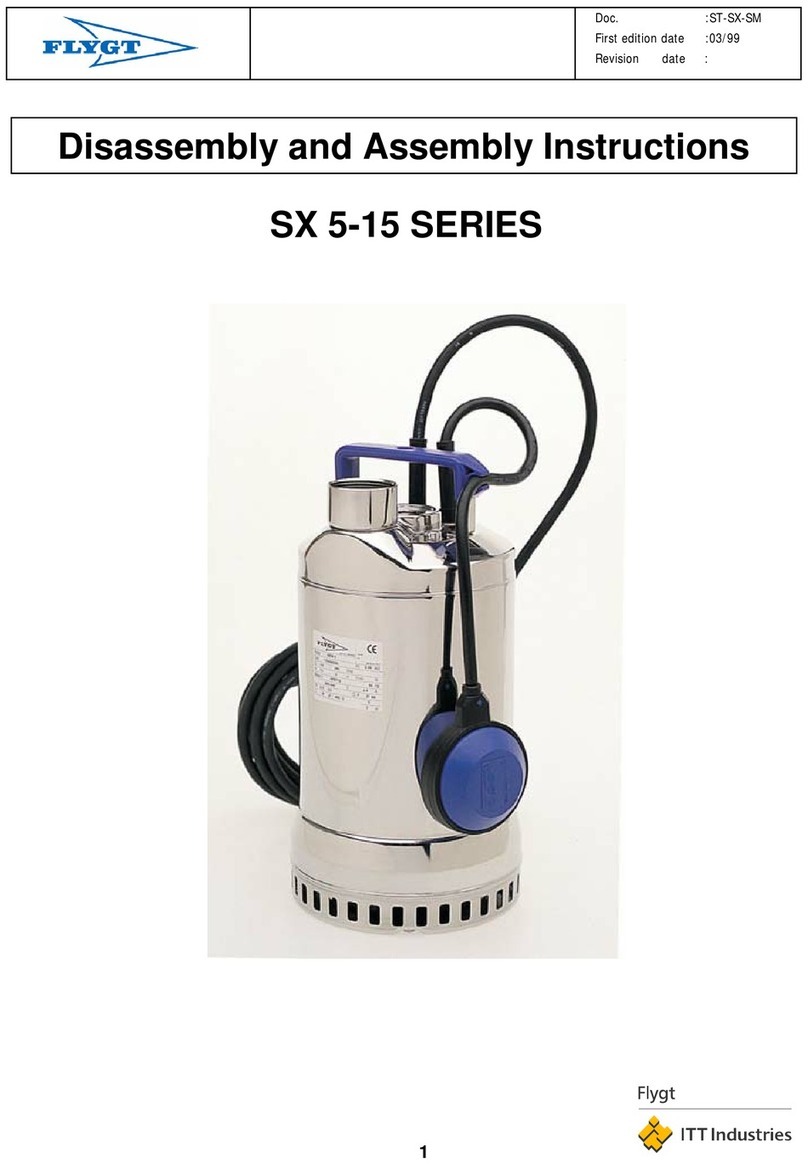
FLYGT
FLYGT SX 5-15 Series User manual
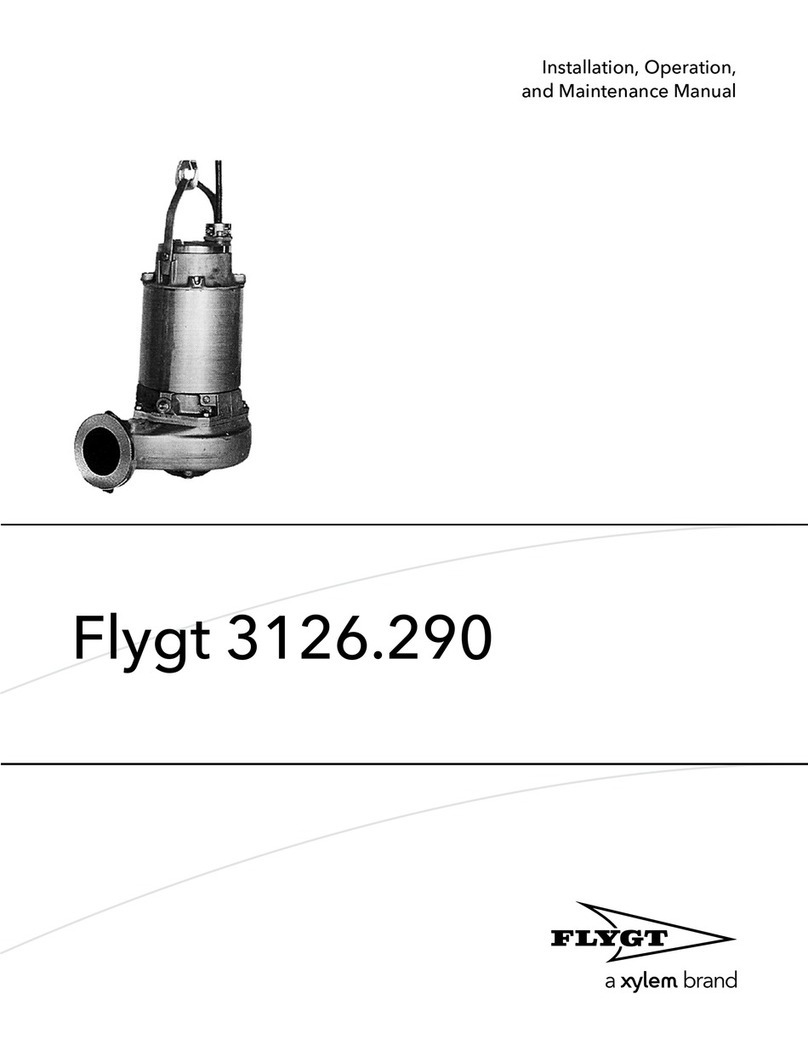
FLYGT
FLYGT 3126.290 User manual

FLYGT
FLYGT 3153 User manual

FLYGT
FLYGT 4630 Maintenance manual
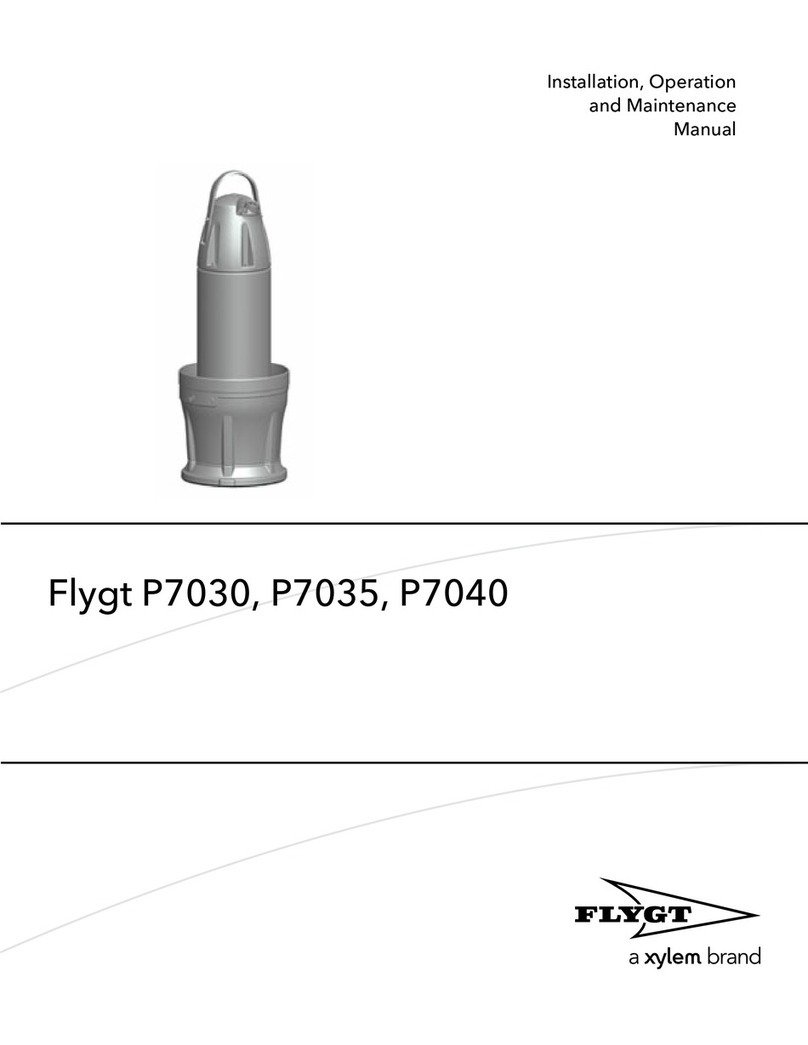
FLYGT
FLYGT P7030 User manual
Popular Water Pump manuals by other brands
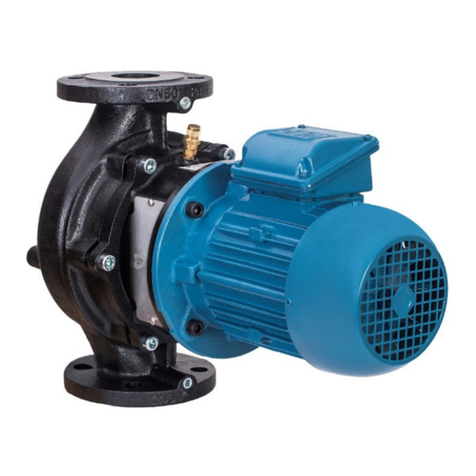
IMP PUMPS
IMP PUMPS CL Series, CV Series Installation and operating manual

Ecoflo
Ecoflo PUP61DC owner's manual

Little Giant
Little Giant 20E-CIM instruction sheet
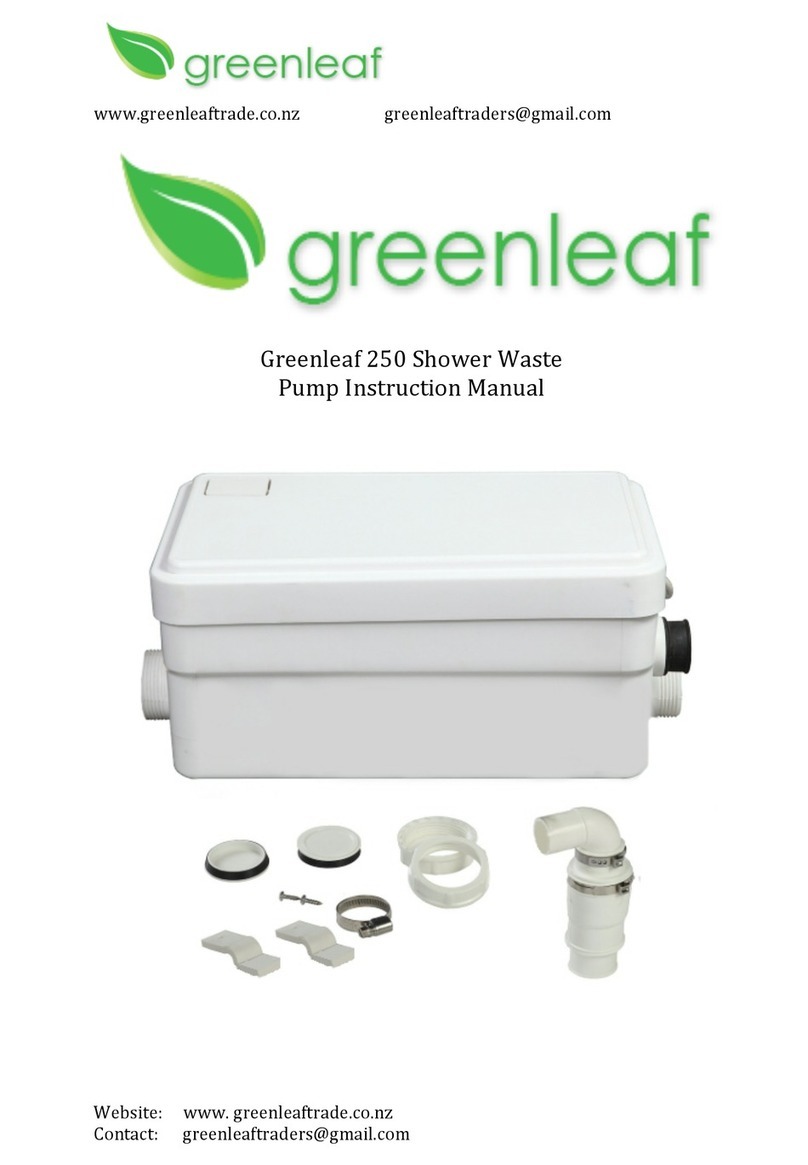
Greenleaf
Greenleaf 250 instruction manual
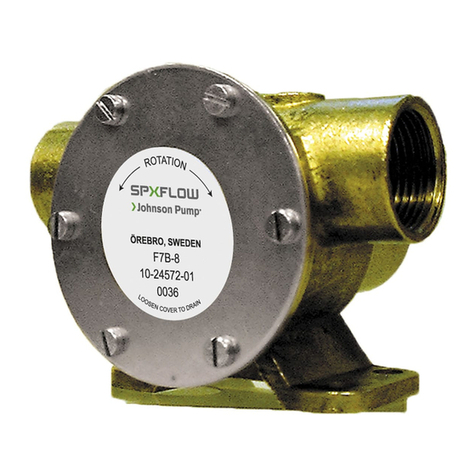
SPX FLOW
SPX FLOW Johnson Pump F35B-8 Series instruction manual
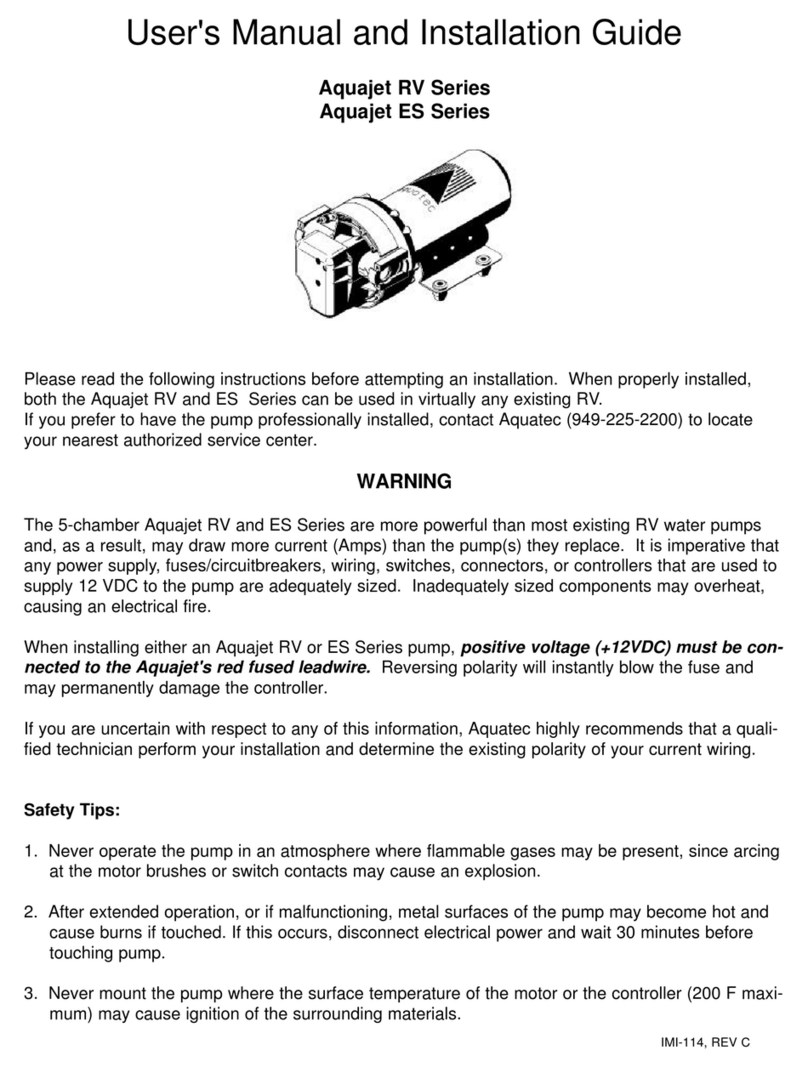
AQUATECH
AQUATECH Aquajet RV Series User manual and installation guide

